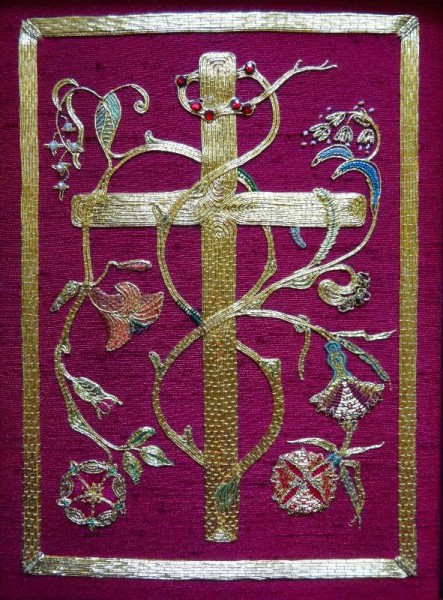
Goldwork embroidered bible in Balliol Library. Hand embroidered by Pauline Johnstone in memory of her husband Kenneth Roy Johnstone and given to the library in 1978. Image published with the permission of the Master and Fellows of Balliol College.
Literally a labour of love, the binding of this bible was hand embroidered by Pauline Johnstone in memory of her husband, Kenneth Roy Johnstone (Balliol 1921). It was given to the college in 1978. I had worked in the college library for some years before I was shown this beautiful piece and since then I have longed for it to be more widely seen and by those who would appreciate its workmanship. As the box the bible is kept in comes with a warning about too much exposure to light, some sort of permanent display is not very likely (although similarly embroidered altar frontals seem to cope with being heaved on and off altars and suffer vast quantities of light exposure, not to mention candle grease, damp and enquiring fingers). Hoorah for the blog post, therefore, as it is the perfect vehicle for getting something so lovely visible to a wider audience.
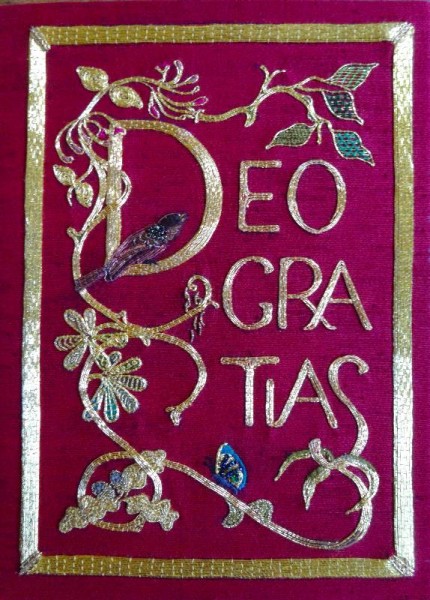
Embroidered bible in Balliol library: back cover.(Hand embroidered by Pauline Johnstone in memory of her husband). Image published with the permission of the Master and Fellows of Balliol College’
Last year the bible was brought out and shown to a group of international designer bookbinders who visited Balliol Archives at St Cross during a day’s tour of college libraries (blogged about here by the archivist).
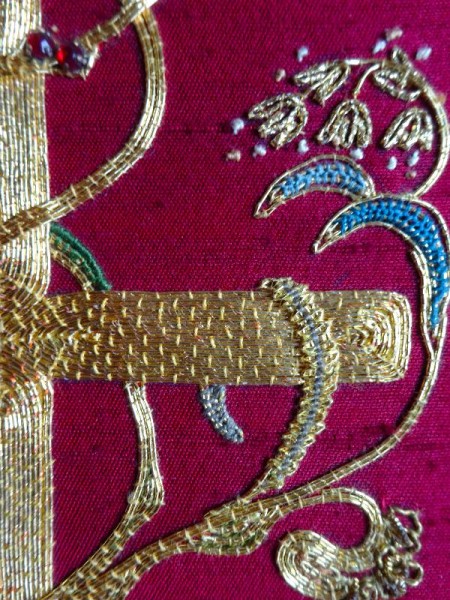
Embroidered goldwork bible in Balliol Library: detail of front (hand embroidered by Pauline Johnstone). Image published with the permission of the Master and Fellows of Balliol College.
I think the design must be Mrs Johnstone’s own, especially as the the medium she chose – goldwork – is not really the sort of thing you find off the peg designs for. Drawing on rich historical precedents, the work is particularly appropriate for a Bible as brings to mind English embroidery at its apogee.
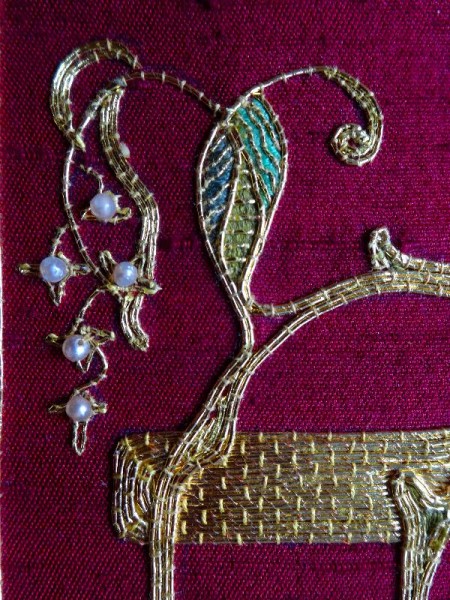
Embroidered goldwork bible in Balliol Library: detail of front (hand embroidered by Pauline Johnstone). Image published with the permission of the Master and Fellows of Balliol College.
In the Middle Ages Opus Anglicanum became famous and sought after throughout Europe, primarily for ecclesiastical use. A Vatican inventory of 1295 lists over 100 items of English embroidery – at this time embroidery was regarded as high art, up there on a par in value and skill alongside painting and goldwork. (For a history of how embroidery descended from the dizzy heights of fine art to being marginalised as just women’s work, read Rozsika Parker’s mind boggling, jaw dropping, read-it-till-your-head-hurts, glorious book, The Subversive Stitch. I have just had a panic as I couldn’t find my copy anywhere – and where was it? In my bedside pile, where it should be for regular revisiting. Phew.)
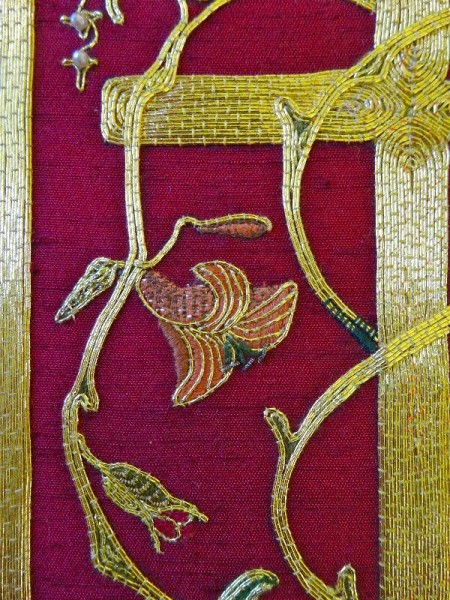
Embroidered goldwork bible in Balliol Library: detail of front (hand embroidered by Pauline Johnstone). Image published with the permission of the Master and Fellows of Balliol College.
Opus Anglicanum was at its very best from the mid-C13 to mid-C14, after which there was a decline in skill and quality as competition came from European workshops and fashions in textiles changed. Italian weavers produced fine brocades and velvets which became the vogue and could be produced more cheaply (comparatively, they were still expensive luxury goods) and more quickly. English embroiderers responded by producing simpler designs with more appliqué work instead of the time consuming practice of filling in designs with stitches. Bands of appliqué were often applied to the new Italian fabric as a way of getting the best of both worlds. However, it is generally agreed that the heart had gone out of English ecclesiastical embroidery and that the zest and verve of embroidered decoration only really returned under the Tudors but this time in a secular context, to adorn palaces and the court.
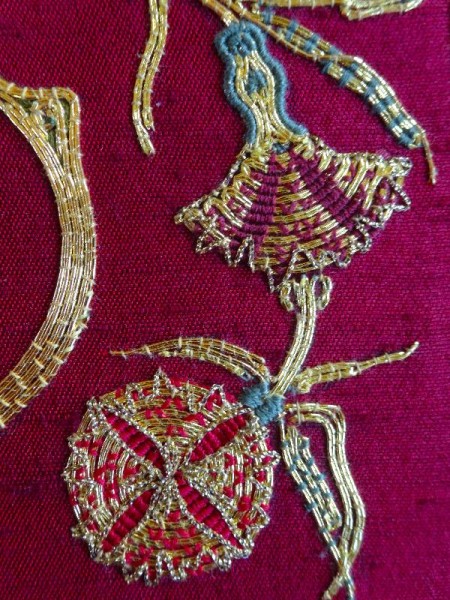
Embroidered goldwork bible in Balliol Library: detail of front (hand embroidered by Pauline Johnstone.) Image published with the permission of the Master and Fellows of Balliol College.
It was not until the C19 that goldwork became fashionable for church use once more with the reforming Oxford movement and under Gothic Revival architects like Pugin and Butterfield (both submitted designs for a new chapel for Balliol; Butterfield was chosen. The college still has Pugin’s designs.) This genre of altar furnishings rumbled on through the early C20 and is still seen on many altars today. Our church in North Stoke has a fine set of gold embroidered altar frontals dating from the early C20th which are still looking good in spite being in need of repair once again.
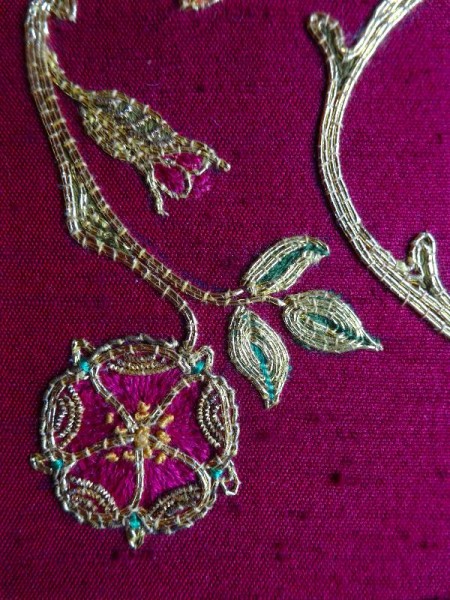
Embroidered goldwork bible in Balliol Library: detail of front (hand embroidered by Pauline Johnstone). Image published with the permission of the Master and Fellows of Balliol College.
Surprisingly, ornate ecclesiastical goldwork was making a quiet comeback during the 1960s while the rest of us were making shift dresses out of next to nothing, jangling with plastic bangles and starting to dip into Laura Ashley’s country chic. Beryl Dean opted for strong designs with clean lines and wasn’t afraid to be the embroiderer’s John Piper.
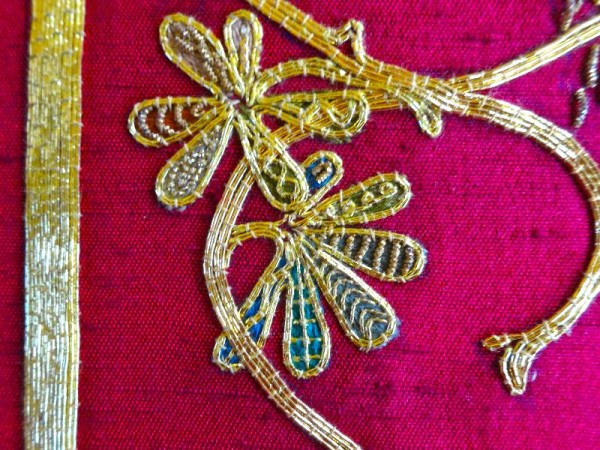
Embroidered goldwork bible in Balliol Library: detail of back (hand embroidered by Pauline Johnstone). Image published with the permission of the Master and Fellows of Balliol College.
But at the root of her sometimes challenging designs was superb skill with the needle, including the difficult or nué (shaded gold) technique in which gold threads, laid over the whole of the embroidery, are couched with different coloured thread. (Pauline has done something similar here although I’m not sure technically whether the term is preferentially used to describe larger areas like that of clothing, or the face where the skill of the embroiderer has to be great to suggest contours of fabric or skin.)
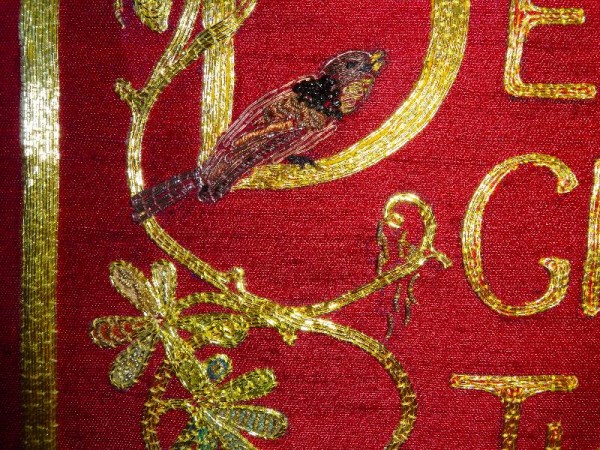
Embroidered goldwork bible in Balliol Library: detail of back (hand embroidered by Pauline Johnstone). Image published with the permission of the Master and Fellows of Balliol College.
Pauline’s designs for the front and back covers are agreeably contrasting. On the front, the sturdy gold cross is softened by the entwined stems and stylised flowers, whilst on the back nature has taken over to sing its own praise to God. Flowers and leaves are embellished with more subtle couching in which coloured silk threads predominate over the gold. Beads, used sparingly, draw attention to details in the design, their ability to catch the light reminding us of the spark of life in the flora and fauna. On the back cover the design includes scrolling foliage on which sits a garden bird of the utmost charm whose open beak visibly sings Deo gratias (Thanks be to God); below a butterfly contemplates sharing the sentiment. Both design and embroidery are of the highest standard.
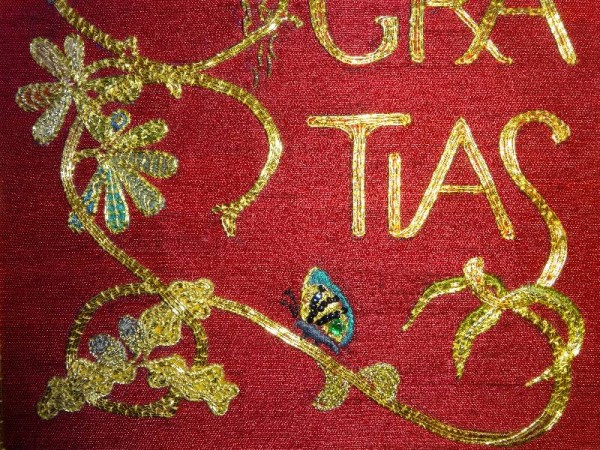
Embroidered goldwork bible in Balliol Library: detail of back (hand embroidered by Pauline Johnstone). Image published with the permission of the Master and Fellows of Balliol College.
Apology: I have taken many photographs of this book – some a year ago and others more recently (in daylight- but not outside/with a lamp/with flash/without flash, etc., etc.) but I have been unable to maintain a consistent colour for red silk of the background. The colour is somewhere between the pinkish-red of the first 7 photographs and the browny-red of the last 2. The 3rd picture from the end is something else again but I wanted to show how each leaflet had been treated differently with that particular photograph. I hope Pauline’s skill has shone through my technical shortcomings.

14 Comments
Utterly beautiful. Thank you for sharing this lovely piece of art. And it is art.
A welcome kind comment in a hectic week. Thank you.
When I opened your blog post, I gasped. How beautiful. What dedication, what love, what art. Thanks for sharing this with me.
Thank you, it is wonderful to bring something so beautiful to a wider and appreciative audience.
Thank you for sharing this beautiful piece, and some of the history of gold work with us!
I always appreciate reading what you have to say about the different things you share. Thank you.
Lovely to have your comment and to hear you enjoyed the post. Thank you.
Pauline’s embroidery, is wonderful Mary – and your blog is the perfect showcase for it. Lovely post.
Glad you liked this hidden gem and thank you for tweeting it – it’s a great pleasure to see it being aired to a wider community than a college library can ever manage. In fact it doesn’t really fit in a library. A former librarian declared that it was beautiful but “not very interesting bibliographically”! It does make you wonder how many other similar things languish away in safe but unsuitable homes.
with many thanks and best wishes, Mary
Hello Mary, Thank you for directing me to your blog. What a beautiful treasure this gold work bible is, thanks for sharing all the exquisite details of Pauline’s work.
You must be privy to so many priceless treasures working at Balliol College. Shall stop by to see more! and I must try your cookie recipes.
Maya – so pleased you looked at my blog. Delighted to find your blog and your charming work.
Thank you so much for this beautiful and informative post. I am a Librarian too, and it amazes me the responsibility we have, not just for protecting such treasure but also for displaying and sharing it. This is such a wonderful way to show it.
It was good to hear from you, Lizzie and thank you so much for taking the time to comment.
Just stumbled upon your blog today and the artwork in this post is breathtaking! Thank you for sharing.
Really glad you enjoyed looking at one of our library’s hidden treasures which will never be admired as much as it should be.